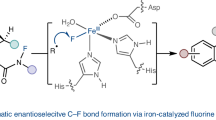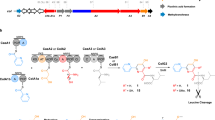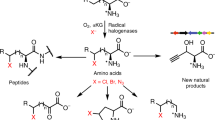Abstract
Secondary metabolites synthesized by non-ribosomal peptide synthetases display diverse and complex topologies and possess a range of biological activities1,2. Much of this diversity derives from a synthetic strategy that entails pre-3 and post-assembly2 oxidation of both the chiral amino acid building blocks and the assembled peptide scaffolds. The vancomycin biosynthetic pathway is an excellent example of the range of oxidative transformations that can be performed by the iron-containing enzymes involved in its biosynthesis4. However, because of the challenges associated with using such oxidative enzymes to carry out chemical transformations in vitro, chemical syntheses guided by these principles have not been fully realized in the laboratory5. Here we report that two small-molecule iron catalysts are capable of facilitating the targeted C–H oxidative modification of amino acids and peptides with preservation of α-centre chirality. Oxidation of proline to 5-hydroxyproline furnishes a versatile intermediate that can be transformed to rigid arylated derivatives or flexible linear carboxylic acids, alcohols, olefins and amines in both monomer and peptide settings. The value of this C–H oxidation strategy is demonstrated in its capacity for generating diversity: four ‘chiral pool’ amino acids are transformed to twenty-one chiral unnatural amino acids representing seven distinct functional group arrays; late-stage C–H functionalizations of a single proline-containing tripeptide furnish eight tripeptides, each having different unnatural amino acids. Additionally, a macrocyclic peptide containing a proline turn element is transformed via late-stage C–H oxidation to one containing a linear unnatural amino acid.
This is a preview of subscription content, access via your institution
Access options
Subscribe to this journal
Receive 51 print issues and online access
$199.00 per year
only $3.90 per issue
Buy this article
- Purchase on Springer Link
- Instant access to full article PDF
Prices may be subject to local taxes which are calculated during checkout




Similar content being viewed by others
Accession codes
Data deposits
The crystal data have been deposited in The Cambridge Crystallographic Data Centre (http://www.ccdc.cam.ac.uk) under accession numbers 1478939, 1478940, and 1478941.
References
Schwarzer, D., Finking, R. & Mahariel, M. Nonribosomal peptides: from genes to products. Nat. Prod. Rep. 20, 275–287 (2003)
Walsh, C. T. et al. Tailoring enzymes that modify nonribosomal peptides during and after chain elongation on NRPS assembly lines. Curr. Opin. Chem. Biol. 5, 525–534 (2001)
Wang, P., Gao, X. & Tang, Y. Complexity generation during natural product biosynthesis using redox enzymes. Curr. Opin. Chem. Biol. 16, 362–369 (2012)
Hubbard, B. K. & Walsh, C. T. Vancomycin assembly: nature’s way. Angew. Chem. Int. Ed. 42, 730–765 (2003)
White, M. C. Adding aliphatic C–H bonds to synthesis. Science 335, 807–809 (2012)
Burke, M. D. & Schreiber, S. L. A planning strategy for diversity-oriented synthesis. Angew. Chem. Int. Ed. 43, 46–58 (2004)
Beckmann, H. G. et al. A strategy for the diversity-oriented synthesis of macrocyclic scaffolds using multidimensional coupling. Nat. Chem. 5, 861–867 (2013)
Dangel, B. D., Johnson, J. A. & Sames, D. Selective functionalization of amino acids in water: a synthetic method via catalytic C–H bond activation. J. Am. Chem. Soc. 123, 8149–8150 (2001)
Gong, W., Zhang, G., Liu, T., Giri, R. & Yu, J.-Q. Site-selective C(sp3)-H functionalization of di-, tri-, and tetrapeptides at the N-terminus. J. Am. Chem. Soc. 136, 16940–16946 (2014)
Saladino, R. et al. A new and efficient synthesis of unnatural amino acids and peptides by selective 3,3-dimethyldioxirane side chain oxidation. J. Org. Chem. 64, 8468–8474 (1999)
Rella, M. R. & Williard, P. G. Oxidation of peptides by methyl(trifluoromethyl)dioxirane: the protecting group matters. J. Org. Chem. 72, 525–531 (2007)
Nájera, C. & Yus, M. Pyroglutamic acid: a versatile building block in asymmetric synthesis. Tetrahedron Asymmetry 10, 2245–2303 (1999)
Ratnikov, M. O., Xu, X. & Doyle, M. P. Simple and sustainable iron-catalyzed aerobic C–H functionalization of N,N-dialkylanilines. J. Am. Chem. Soc. 135, 9475–9479 (2013)
Zuo, Z. & MacMillan, D. W. C. Decarboxylative arylation of α-amino acids via photoredox catalysis: one-step conversion of biomass to pharmacophores. J. Am. Chem. Soc. 136, 5257–5260 (2014)
Turner, N. J. Enantioselective oxidation of C–O and C–N bonds using oxidases. Chem. Rev. 111, 4073–4087 (2011)
Rauk, A. et al. Effect of structure on αC-H bond enthalpies of amino acid residues: relevance to H-transfers in enzyme mechanism and protein oxidation. Biochemistry 38, 9089–9096 (1999)
Uchida, K., Kato, Y. & Kawakishi, S. A novel mechanism for oxidative cleavage of prolyl peptides induced by the hydroxyl radical. Biochem. Biophys. Res. Commun. 169, 265–271 (1990)
Shaw, M. H., Shurtleff, V. W., Terrett, J. A., Cuthbertson, J. D. & MacMillan, D. W. C. Native functionality in triple catalytic cross-coupling: sp3 C–H bonds as latent nucleophiles. Science 352, 1304–1308 (2016)
Chen, M. S. & White, M. C. A predictably selective aliphatic C–H oxidation reaction for complex molecule synthesis. Science 318, 783–787 (2007)
Chen, M. S. & White, M. C. Combined effects on selectivity in Fe-catalyzed methylene oxidation. Science 327, 566–571 (2010)
Gormisky, P. E. & White, M. C. Catalyst-controlled aliphatic C–H oxidations with a predictive model for site-selectivity. J. Am. Chem. Soc. 135, 14052–14055 (2013)
Scola, P. M. et al. The discovery of Asunaprevir (BMS-650032), an orally efficacious NS3 protease inhibitor for the treatment of Hepatitis C virus infection. J. Med. Chem. 57, 1730–1752 (2014)
Stevenazzi, A., Marchini, M., Sandrone, G., Vergani, B. & Lattanzio, M. Amino acidic scaffolds bearing unnatural side chains: an old idea generates new and versatile tools for the life sciences. Bioorg. Med. Chem. Lett. 24, 5349–5356 (2014)
Seiple, I. B., Mercer, J. A. M., Sussman, R. J., Zhang, Z. & Myers, A. G. Stereocontrolled synthesis of syn-β-hydroxy-α-amino acids by direct aldolization of pseudoephenamine glycinamide. Angew. Chem. Int. Ed. 53, 4642–4647 (2014)
Driggers, E. M., Hale, S. P., Lee, J. & Terrett, N. K. The exploration of macrocycles for drug discovery—an underexploited structural class. Nat. Rev. Drug Discov. 7, 608–624 (2008)
Yudin, A. K. Macrocycles: lessons from the distant past, recent developments, and future directions. Chem. Sci. 6, 30–49 (2015)
Schafmeister, C. E., Po, J. & Verdine, G. L. An all-hydrocarbon crosslinking system for enhancing the helicity and metabolic stability of peptides. J. Am. Chem. Soc. 122, 5891–5892 (2000)
Miller, S. J., Blackwell, H. E. & Grubbs, R. H. Application of ring-closing metathesis to the synthesis of rigidified amino acids and peptides. J. Am. Chem. Soc. 118, 9606–9614 (1996)
Lau, Y. H. et al. Functionalized staple linkages for modulating the cellular activity of stapled peptides. Chem. Sci. 5, 1804–1809 (2014)
White, C. J. & Yudin, A. K. Contemporary strategies for peptide macrocyclization. Nat. Chem. 3, 509–524 (2011)
Acknowledgements
Financial support for this work was provided by the NIH/National Institute of General Medical Sciences (GM112492) and a grant from Pfizer to study the modification of natural products and medicinal compounds. T.J.O. is a Springborn Graduate Fellow. We thank L. Zhu for assistance with nuclear magnetic resonance spectroscopy, D. Gray and J. Bertke for X-ray crystallographic studies, A. I. Greenwood and J. Zhao for calculations on product (−)-10, W. A. van der Donk for use of his HPLC instrument, X. Yang and X. Zhao for assistance with Marfey’s reagent for chiral amino acid analysis of tripeptide (−)-53, C. Jiang for preliminary studies of amino acid oxidations, and G. S. Snapper for substrate synthesis.
Author information
Authors and Affiliations
Contributions
T.J.O. and D.C.R. conducted the experiments and analysed the data. M.C.W. and T.J.O. wrote the manuscript. M.C.W., J.T.K., A.F.S., T.J.O. and D.C.R. designed the project. All authors provided comments on the experiments and manuscript during its preparation.
Corresponding author
Ethics declarations
Competing interests
The authors declare no competing financial interests.
Supplementary information
Supplementary Information
This file contains Supplementary Text and Data – see contents page for details. (PDF 7671 kb)
Rights and permissions
About this article
Cite this article
Osberger, T., Rogness, D., Kohrt, J. et al. Oxidative diversification of amino acids and peptides by small-molecule iron catalysis. Nature 537, 214–219 (2016). https://doi.org/10.1038/nature18941
Received:
Accepted:
Published:
Issue Date:
DOI: https://doi.org/10.1038/nature18941
This article is cited by
-
The interplay of polar effects in controlling the selectivity of radical reactions
Nature Synthesis (2022)
-
Radical C(sp3)–H functionalization and cross-coupling reactions
Nature Reviews Chemistry (2022)
-
Copper catalyzed late-stage C(sp3)-H functionalization of nitrogen heterocycles
Nature Communications (2021)
-
Late-stage oxidative C(sp3)–H methylation
Nature (2020)
-
Ring-opening functionalizations of unstrained cyclic amines enabled by difluorocarbene transfer
Nature Communications (2020)
Comments
By submitting a comment you agree to abide by our Terms and Community Guidelines. If you find something abusive or that does not comply with our terms or guidelines please flag it as inappropriate.



